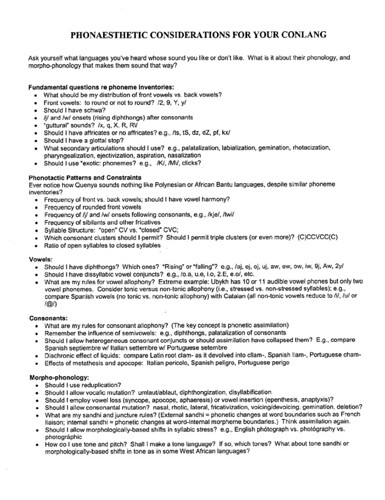
Here is the handout made by John Quijada for his talk at the 2nd LCC:
If you click on the image, it will take you to my Flickr account and you can see the full-size version; even print it out if you like.
It seemed like such a basic idea when I first heard it, but it really is at the heart of making a language: how do you want your language to sound? And even deeper than that, what character does your language have?
There was a word John showed us: sprachgefuhl. It means "the character of a language," among other things. We all know that French is a pretty soft language, the "language of love," and so forth. We know that Japanese, German, and Norwegian sound completely different from each other. These languages have a very different "feel" from each other. How will your language feel different? Or do you want it to feel different? Maybe you want your conlang to feel similar to some other language. What characteristics will your language have that will make it unique? Or what are the unique characteristics of the language you want to emulate? On this handout, John Quijada remarks on how Quenya (Tolkien's elvish language) sound nothing like Polynesian or African Bantu languages, despite having similar phonemic inventories. Interesting, huh?
There are a lot of options on this sheet that could go over your head if you look at them all at once. I suggest a strategy or exercise (whichever you prefer): consider each item individually, write out your selection on a page somewhere, then look at your answers and try to think out how this language might look or sound. Generate some words and put together a few sentences. Then go through it again with a new page and change a few things. See how it changes and compares to the last page. Try this a few times and get a feel for how the pieces of language fit together and change the overall picture of a language.
Comments
Thank you for bringing this to my attention. I've saved the image to my hard drive, and I'll go over it later on once I've had some time to educate myself on the topics it discusses.
- Baalak Nalzar-aung.